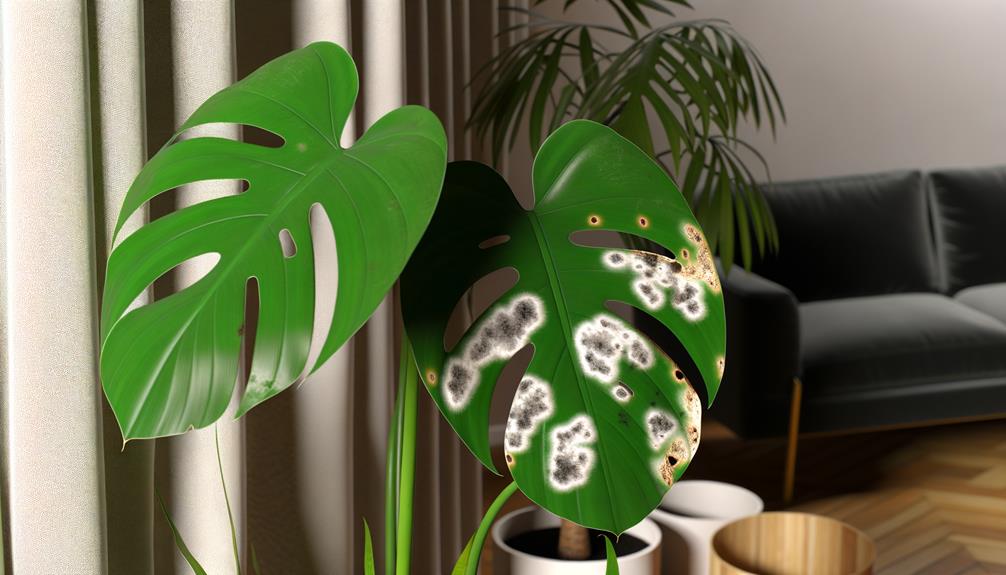Fungal Infection in Monstera Deliciosa
Fungal infections in Monstera Deliciosa often arise from overwatering and high humidity. Symptoms include dark leaf spots, yellow halos, and powdery substances on foliage.
Common fungal issues are anthracnose, powdery mildew, and root rot. To manage these, maintain humidity at 40-60%, use sterilized tools, and adopt proper watering techniques.
Treatments include fungicidal sprays, pruning infected parts, and improving air circulation. For a natural approach, consider neem oil or baking soda.
Prompt action can prevent severe damage. If you're looking for detailed steps and preventive measures, you'll find plenty of actionable tips and expert advice right here.

Key Takeaways
- Overwatering and poor drainage are primary causes of fungal infections in Monstera Deliciosa.
- Early symptoms include small dark spots, yellow halos, and white or gray powdery substance on leaves.
- Types of fungal infections include Anthracnose, Powdery mildew, Root rot, Botrytis cinerea, and Fusarium wilt.
- Preventive measures include maintaining humidity levels at 40-60%, using sterilized tools, and proper watering techniques.
- Management strategies involve using fungicidal sprays, pruning infected parts, and improving air circulation.
Common Causes
Fungal infections in Monstera Deliciosa are often caused by overwatering, poor drainage, or high humidity levels.
First, overwatering creates a consistently damp environment, which fungi thrive in. You should make sure the soil dries out between waterings to prevent this.
Second, poor drainage exacerbates the issue by allowing water to pool at the roots, creating ideal conditions for fungal growth. Using well-draining soil and pots with drainage holes can lessen this risk.
Finally, high humidity levels, while beneficial for Monstera, can also promote fungal development if not balanced properly. Maintaining a humidity level around 60% and ensuring adequate air circulation can help.
Early Symptoms
Monitoring your Monstera Deliciosa for early symptoms of fungal infection is essential to prevent severe damage. Start by examining the leaves for small, dark spots that may expand and become irregularly shaped. These spots often have yellow halos, indicating fungal presence.
Check the underside of the leaves for a white or gray powdery substance, a sign of mildew. Observe the stem for soft, mushy areas, which could signal stem rot.
Additionally, be aware of any changes in leaf color, such as yellowing or browning, which may suggest nutrient uptake issues caused by fungal interference. Early detection allows for prompt treatment, minimizing the risk of spread to healthy tissues.
Consistent monitoring helps maintain your plant's overall health.
Types of Fungal Infections
To effectively manage fungal infections in your Monstera Deliciosa, you need to understand common fungal pathogens, their symptoms, and identification methods. Recognizing these factors will enable you to implement effective prevention and treatment strategies.
Let's explore the specific types of fungal infections you might encounter.
Common Fungal Pathogens
You'll often encounter several common fungal pathogens affecting Monstera Deliciosa, each causing distinct symptoms and challenges.
Anthracnose, caused by Colletotrichum species, leads to leaf spots and blight.
Powdery mildew, from the Erysiphales order, creates a white, powdery growth on leaves.
Root rot, typically due to Pythium or Phytophthora species, results in decayed roots and wilted foliage.
Botrytis cinerea, known as gray mold, affects stems and leaves, producing a fuzzy gray appearance.
Fusarium wilt, caused by Fusarium oxysporum, leads to yellowing and wilting.
Understanding these pathogens is vital for effective management. Identifying the specific fungal culprit allows you to tailor your treatment, ensuring the health and longevity of your Monstera Deliciosa.
Symptoms and Identification
Recognizing the symptoms of different fungal infections in Monstera Deliciosa is key to accurate identification and effective treatment. Various fungi manifest distinct symptoms, making it essential to know what to look for.
- Powdery Mildew: You'll notice a white, powdery substance on the leaves. It often starts as small, round spots and can cover large areas if left untreated.
- Root Rot: This typically results from overwatering. Look for wilted leaves, a mushy stem base, and black, decaying roots.
- Leaf Spot: Characterized by brown or black spots with yellow halos on the foliage, often leading to leaf drop.
Prevention and Treatment
Effectively preventing and treating fungal infections in Monstera Deliciosa hinges on understanding the specific requirements and vulnerabilities of the plant. Over-watering and poor air circulation often lead to fungal infections like root rot, powdery mildew, and leaf spot. To prevent these, maintain a consistent watering schedule, ensuring the soil is well-draining. Increase air circulation by placing the plant in a well-ventilated area.
When you notice early signs of infection, act quickly. Trim affected leaves with sterilized tools to prevent spreading. Use fungicides specifically designed for ornamental plants, following the manufacturer's instructions precisely.
Regularly inspect your Monstera for any signs of distress, as early detection is essential for effective treatment. Consistent care and vigilance are key to maintaining a healthy Monstera Deliciosa.
Identifying Leaf Spots
To identify leaf spots on your Monstera Deliciosa, start by looking for common symptoms like discoloration and lesions. You'll often notice yellow, brown, or black spots, which can be irregularly shaped.
Use a visual indicators guide to compare these symptoms and pinpoint the type of fungal infection affecting your plant.
Common Symptoms Overview
Identifying leaf spots in Monstera Deliciosa involves scrutinizing the plant for discolorations, lesions, or unusual markings that deviate from its typical lush green appearance.
You need to pay close attention to the following common symptoms that could indicate a fungal infection:
- Yellow Haloes: Small brown or black spots surrounded by yellow borders often signal fungal activity.
- Necrotic Patches: Dead tissue areas that appear dry and brown can spread, leading to overall leaf deterioration.
- Water-soaked Lesions: These translucent, wet-looking spots can quickly turn brown and dry out, indicating advanced infection.
Visual Indicators Guide
When inspecting your Monstera Deliciosa for potential fungal infections, focus on the distinct visual indicators that differentiate benign markings from problematic leaf spots.
Look for small, brown or black spots that often have a yellow halo around them. These spots may enlarge over time and merge, leading to larger areas of necrosis.
Unlike nutrient deficiencies that typically manifest as uniform discoloration, fungal spots are irregular and may appear slightly sunken. Additionally, check for a fuzzy or powdery texture on the spots, indicating fungal spore presence. Consistently damp conditions exacerbate these symptoms.
Early detection is essential; remove affected leaves promptly and adjust watering practices. Use a fungicide if the infection persists, ensuring it's appropriate for Monstera species.
Preventive Measures
By maintaining proper watering habits and guaranteeing adequate air circulation, you can greatly reduce the risk of fungal infections in your Monstera Deliciosa. Consistent care practices create an environment that discourages fungal growth.
Here are three key preventive measures:
- Monitor Humidity Levels: Keep humidity around 40-60%. High humidity can encourage fungal growth, while too low can stress the plant.
- Use Sterile Tools: Always use sterilized pruning shears and pots. Contaminated tools can introduce fungal spores.
- Inspect Regularly: Check your plant weekly for early signs of infection, such as spots or mold. Early detection helps in prompt intervention.
Applying these practices guarantees that you maintain a healthy Monstera Deliciosa, minimizing the chances of fungal infections.
Proper Watering Techniques
Consistently delivering the right amount of water is crucial for preventing fungal infections in your Monstera Deliciosa. You should water the plant when the top 2-3 inches of soil feel dry to the touch.
Overwatering can lead to waterlogged soil, creating an ideal environment for fungi. Conversely, underwatering can stress the plant, making it more susceptible to infections. Use a pot with drainage holes and well-draining soil to facilitate proper water flow.
Avoid letting the plant sit in excess water by emptying the saucer beneath the pot after watering. It's also beneficial to water in the morning, allowing any excess moisture to evaporate throughout the day, thereby reducing humidity levels around the plant.
Effective Treatments
To effectively treat fungal infections in Monstera Deliciosa, you must first accurately identify the specific type of fungus affecting the plant. Once identified, employ targeted treatments to make certain the fungus is eradicated.
Fungicidal Sprays: Utilize a commercial fungicide specific to the fungal type. Apply as directed, ensuring thorough coverage of infected areas.
Pruning: Remove and dispose of infected leaves and stems. Sterilize pruning tools between cuts to prevent spreading the fungus.
Environmental Control: Adjust humidity levels and improve air circulation around the Monstera. Proper ventilation helps inhibit fungal growth.
Follow these steps meticulously, and you'll minimize the risk of the infection recurring. Your Monstera Deliciosa will thrive with these precise, effective treatments.
Natural Remedies
While commercial fungicides are effective, you might prefer natural remedies to treat fungal infections in your Monstera Deliciosa. Neem oil is a popular option; it possesses antifungal properties that can combat various pathogens. Dilute it with water, then spray it on infected areas.
Baking soda, another effective remedy, alters the pH level on leaf surfaces, inhibiting fungal growth. Mix one tablespoon of baking soda with one gallon of water and apply it to affected parts.
Additionally, cinnamon acts as a natural fungicide due to its cinnamaldehyde content. Sprinkle cinnamon powder on the soil or directly on infected areas. These methods not only address fungal issues but also minimize chemical exposure, promoting a healthier environment for your Monstera.
When to Seek Help
When should you seek professional help for your Monstera Deliciosa's fungal infection? It's important to act promptly if you observe severe symptoms that home remedies can't resolve.
Look out for these signs:
- Rapid Spread: If the fungal infection spreads quickly despite your efforts, it's time to consult an expert.
- Persistent Symptoms: When discoloration, wilting, or spotting persists for over two weeks, professional intervention is needed.
- Structural Damage: If the plant's structural integrity is compromised, such as extensive stem rot or major leaf loss, seek help immediately.
Ignoring these signs can lead to irreversible damage. A professional can provide targeted treatments and advice to save your plant. Don't hesitate to reach out to an expert to ensure your Monstera thrives.
Conclusion
To sum up, managing fungal infections in your Monstera deliciosa is essential for its health. By recognizing early symptoms and understanding different fungal types, you can act promptly.
Think of preventive measures and proper watering like armor, safeguarding your plant from harm. Effective treatments and natural remedies are your go-to tools.
If issues persist, don't hesitate to seek professional assistance. Your watchfulness guarantees that your Monstera thrives, free from the hold of harmful fungi.






